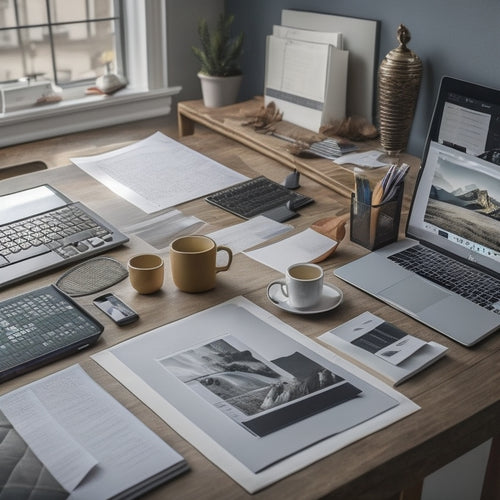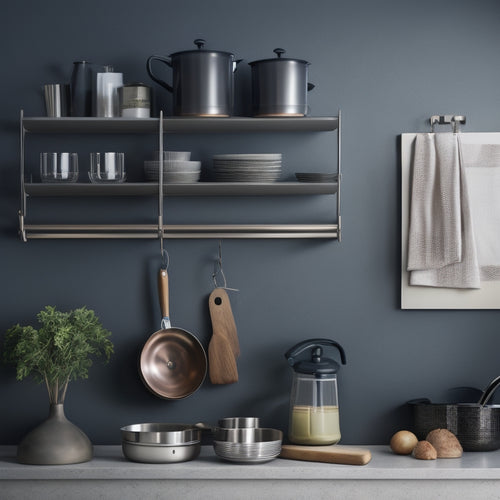Revamp Your Workspace: Craft the Perfect Studio
Share
As I revamp my workspace, I'm focusing on natural light, ample table space, and storage solutions to fuel my creativity. I'm positioning my table strategically to spark ideas and incorporating ergonomic design for comfort. By tackling technical challenges and incorporating customized elements, I'm creating a space that's tailored to my unique needs. Every detail, from warm lighting to plush textiles, is designed to inspire my artistic vision. As I curate my studio, I'm crafting an atmosphere that sparks imagination and creativity - and I'm excited to see where this transformation takes me next.
Key Takeaways
• Incorporate natural light and ergonomic design to create a harmonious and functional workspace that fosters creativity and comfort.
• Assess your unique needs and hobbies, such as painting or photography, to tailor your studio's layout and storage solutions.
• Position tables and supplies strategically to maximize space, reduce clutter, and enhance productivity.
• Balance form and functionality by incorporating aesthetic appeal with practical features, such as built-in storage and thoughtful color choices.
• Address technical challenges, like electrical needs and structural solutions, to create a seamless and efficient workspace that sparks inspiration.
Understanding Workspace Requirements
As I step into the 10.5 feet by 12.5 feet studio, I'm struck by the interplay of natural light and the potential for creative chaos, and I know that understanding the client's needs and workspace requirements is key to crafting a harmonious and functional space that nurtures artistic expression.
A thorough workplace analysis is essential in identifying the client's specific needs, such as ample table space, storage solutions, and an uncluttered workspace. I consider the client's work requirements, art creation, and hobbies like painting, yoga, and photography to create a space that caters to their unique needs.
Optimizing Space and Creativity
By strategically positioning tables against well-lit walls, I can ignite the full creative potential of this studio, fostering an atmosphere that sparks inspiration and productivity.
Natural lighting pours in, illuminating my workspace and energizing my creativity. To maximize space, I incorporate creative storage solutions, like hanging shelves and multi-tiered tables, keeping essential art supplies within easy reach.
This thoughtful design enables me to focus on my art, rather than worrying about clutter and disorganization. With a clear mind and a well-organized space, I can fully immerse myself in the creative process, allowing my imagination to flourish.
As I work, I feel a sense of harmony between my surroundings and my art, fueling my passion and inspiring my next masterpiece.
Designing for Ergonomics and Function
With every brushstroke and artistic gesture, I'm acutely aware of the importance of ergonomic design in my studio. A thoughtful layout can make all the difference between comfort and fatigue, creativity and frustration.
As I plan my ideal workspace, I prioritize designing for comfort and functionality. By positioning my art tables near natural light sources and incorporating ergonomic chairs, I guarantee that I can work for hours without discomfort.
Improving productivity is key, so I'm mindful of the 'golden zone' – the area within easy reach – and strategically place my most-used art supplies.
Addressing Technical Challenges
Frequently, I encounter technical challenges that can make or break the functionality of my studio, and addressing these issues head-on is crucial to creating a space that truly supports my artistic vision.
One major hurdle is finding structural solutions that can support heavy tables and shelves, ensuring my walls can bear the weight. I also need to take into account electrical needs, consulting electricians to determine the best wiring and socket placement for my equipment.
By tackling these technical challenges, I can create a seamless and efficient workspace that lets my creativity shine.
With careful planning, I can turn my studio into a haven of productivity, where art and innovation thrive.
Customized Workspace Design Solutions
As I envision my ideal studio, I'm excited to explore customized design solutions that cater to my unique needs, blending functionality with creativity to foster a space that sparks inspiration and fuels my artistic passion.
I'm drawn to personalized design elements that reflect my artistic personality, such as a bespoke art pantry, ergonomic workstations, and tailored storage solutions. Efficient storage is key to maintaining a clutter-free space, allowing me to focus on my craft.
I envision floor-to-ceiling shelves for art supplies, hidden compartments for valuable equipment, and cleverly designed tables with built-in storage. By incorporating these customized features, I'll create a studio that not only sparks creativity but also supports my artistic vision.
Balancing Form and Functionality
In my ideal studio, every element, from the bespoke art pantry to the ergonomic workstations, must strike a delicate balance between aesthetic appeal and functional practicality. I envision a space where artistic inspiration flows freely, and every detail serves a purpose.
The bespoke art pantry, with its carefully curated supplies, is both a functional storage solution and a visual feast. The ergonomic workstations, designed to minimize fatigue and maximize creativity, are sleek and modern, yet warm and inviting. As I move through the space, I feel inspired by the harmonious blend of form and function.
The workspace aesthetics are carefully crafted to spark creativity, with an emphasis on natural light, clean lines, and thoughtful color choices. In this space, I'm free to focus on my art, unencumbered by clutter or distraction.
Bringing Your Studio to Life
With every brushstroke, I envision my studio coming alive, as the carefully crafted design elements, from the bespoke art pantry to the ergonomic workstations, converge to create a vibrant space that fuels my creativity.
As I personalize the decor with meaningful trinkets and artwork, the space transforms into a reflection of my artistic soul. I'm not just designing a workspace – I'm crafting an atmosphere that inspires.
Enhancing the ambiance with warm lighting and plush textiles, I create a haven that nurtures my creative spirit. Every element, from the ergonomic chair to the statement piece of art, is carefully curated to stimulate my imagination and bring my studio to life.
Frequently Asked Questions
How Can I Incorporate Natural Elements Into My Studio Design?
"Did you know that 1 in 5 people feel 'nature-deprived'? I'm incorporating natural elements into my studio design by installing a living wall, using nature-inspired colors, and adding plants to boost creativity and serenity!"
What Are Some Space-Saving Hacks for Small Studios?
As I design my dream studio, I'm obsessed with space-saving hacks - foldable desks that tuck away when not in use and corner shelves that maximize vertical storage, keeping my creative space clutter-free and inspiring.
Can I Reuse or Repurpose Old Furniture in My New Studio?
As I breathe new life into forgotten treasures, I'm a furniture flipper extraordinaire, transforming vintage relics into upcycled decor that oozes charm, proving that thrifty finds can become one-of-a-kind studio staples, repurposed with love and creativity.
How Do I Ensure Good Air Quality in a Studio With Limited Ventilation?
To safeguard good air quality in my studio, I'll prioritize ventilation by installing air purifiers, upgrading to a high-efficiency ventilation system, and incorporating plants that naturally purify the air, creating a healthier workspace that sparks creativity.
Are There Any Specific Design Considerations for Left-Handed Artists?
As a designer, I consider left-handed artists' needs by incorporating ergonomic layouts and ambidextrous tools, ensuring seamless workflow and comfort, and reimagining traditional studio layouts to cater to their unique requirements.
Related Posts
-

Maximize Space With These Top Organization Apps
You're just a few clicks away from maximizing your space and time! Start by decluttering your digital life, then opti...
-

Granite Top Island Design and DIY Installation
You're planning to create a stunning granite top island that enhances your kitchen's functionality and style. To get ...
-

Corner Kitchen Utensil Storage Solutions
You're likely wasting up to one-third of your cabinet space in corner areas, but with the right storage solutions, yo...


